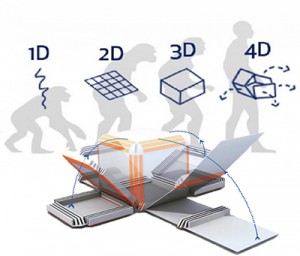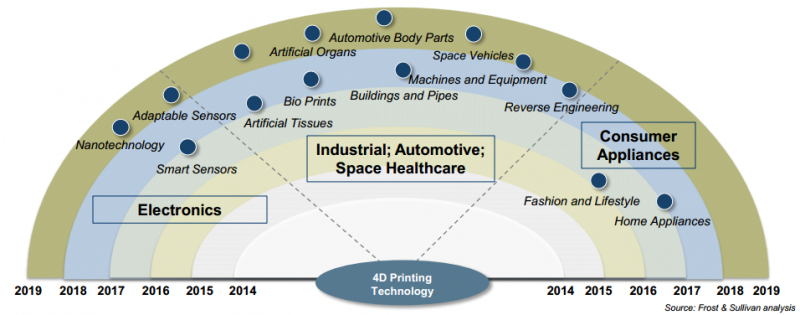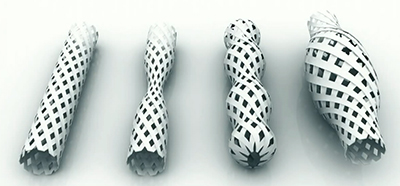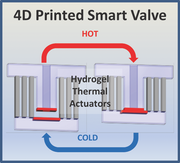3D printing is still a fledgling industry, despite having been around for a while. But what is 4D printing?
is still a fledgling industry, despite having been around for a while. But what is 4D printing?
4D printing technique is unfolding as a technology that takes 3D printing to an entirely new level. First invented at MIT in 2013, it consists of smart materials that adapt and re-programme their properties, functionality or shape on demand, based upon external stimuli (such as submersion in water, or exposure to heat, pressure, current, ultraviolet light, or some other source of energy).
Researchers are combining different types of plastics and fibres to create smart materials that self-assemble or change shape after 3D printing. Here, the fourth dimension relates to the time taken for the self-transformation.
Looking for plastics materials for your project?
Prospector has thousands of material listings and data sheets ready for you to research.
Search Plastics Materials
According to early reports, 4D printing technology is expected to be commercialised in 2019. After that, the global 4D printing market is expected to grow at a CAGR of 42.98% between 2019 and 2025. The market is segmented on the basis of material segments into programmable carbon fibre, programmable wood grain, and programmable textiles. The programmable carbon fibre segment is expected to be the largest contributor to the overall market, with a share of around 62% of the market, in 2019.

But while 4D printing has potential for the future, it also faces challenges:
- the printing process is relatively slow compared to other methods – printing large objects can take days;
- there is a limitation with respect to the materials that can be used (the materials currently available are nowhere as strong or effective as those used in other modern manufacturing processes)
- 4-D printing faces the limitation of size.
- Most early applications utilise water absorption or thermal shape memory, but are slow to respond, and restricted to bending motions that generate little force.
- The shape-shifting is only reversible only up to a point.
But the technology is very young and is likely to take big steps forward as 3D printing becomes more accessible.

Some of the early key players in this market include 3D Systems, Autodesk, Hewlett Packard, Stratasys, ExOne, Organovo Holdings (all US), plus Materialise (Belgium) and Dassault Systèmes SA (France). The end-user industries for which the 4D printing technology is expected to be used include aerospace, automotive, clothing, construction, military and defence, healthcare and the utilities. As 3D printing technology matures with more printable materials and higher resolution at larger scales, the researchers believe the technology will help provide a new approach to creating reversible or tuneable 3D surfaces and solids in engineering, like the composite shells of complex shapes used in automobiles, aircraft and antennas.
So far, examples of 4D printing have included simple self-assembling bodies that fold together when baked, polymers that bend into shape in response to water, heat or pressure, and smart strands inspired by self-assembling nanostructures. A recently produced example is a fully wearable dress printed in one single piece, in a collaboration between Shapeways and the Nervous System design studio.

The Kinematics Dress emanates from a design studio called Nervous System which uses novel computer simulation to generate designs and convert them into products using digital fabrication. The products are in the art, jewellery and housewares area, but the dress represents an interesting departure. The custom-fit dress is an intricately patterned structure of thousands unique triangular panels interconnected by hinges, all 3D printed as a single piece in nylon.
The company employs smart folding to compress Kinematics garments into a smaller form for efficient fabrication. By folding the garments prior to printing them, complex structures are made which are larger than a 3D printer and which unfold into their intended shape.
While each component is rigid, in aggregate, they behave as a continuous fabric allowing the dress to flexibly conform and fluidly flow in response to body movement. Unlike traditional fabric, this textile is not uniform; it varies in rigidity, drape, flex, porosity and pattern through space.
Meanwhile, scientists at the Australian University of Wollongong have developed a special hydrogel that goes in a very different direction, generating quick, reversible and mechanically reliable changes of shape in response to changes in water temperature. The hydrogel material is compatible with a 3D printer. The team sees applications for them in medical soft robotics.
An ionic covalent entanglement (ICE) hydrogel can be 3D printed and demonstrate high toughness. This is important, since thin sections are needed that can respond quickly to external stimuli but also need to be mechanically robust to support the internal and external mechanical loads.
ICE gels are a type of an interpenetrating polymer network that is made up of an entanglement of one polymer network crosslinked with metal cations and a second polymer network crosslinked with covalent bonds. The gels shows reversible length changes of 41%–49% when heated and cooled between 20 and 60C. Blocked stresses generated in tension were in the range of 10–21kPa.
The unique structure of the 4D printing hydrogel toughens the material and prevents microscopic cracks from forming, thus avoiding mechanical failures. Beyond a temperature of about 35C, the gel quickly loses its water content and shrinks down in volume by nearly 50%.

The researchers have used this phenomenon to 3D-print a valve that closes when exposed to hot water and opens once water temperature drops. Unlike a standard 3D-printed material, the gel morphs without human intervention and can repeatedly open and close without straining.
The smart valve controls the flow of water by printing a gel ink alongside other static materials. The valve, a 3D printed structure, includes the actuators, which are activated solely by the introduction of water. The valve automatically closes upon exposure to hot water, reducing the flow rate by 99%, and opens in cold water. With CAD modelling, this 4D printing technique can be easily extended to make other types of moving structures.
Shannon E. Bakarich , Robert Gorkin III , Marc in het Panhuis, Geoffrey M. Spinks*
4D Printing with Mechanically Robust, Thermally Actuating Hydrogels
Macromol. Rapid Commun. 2015, 36, 1211−1217
The views, opinions and technical analyses presented here are those of the author or advertiser, and are not necessarily those of ULProspector.com or UL Solutions. The appearance of this content in the UL Prospector Knowledge Center does not constitute an endorsement by UL Solutions or its affiliates.
All content is subject to copyright and may not be reproduced without prior authorization from UL Solutions or the content author.
The content has been made available for informational and educational purposes only. While the editors of this site may verify the accuracy of its content from time to time, we assume no responsibility for errors made by the author, editorial staff or any other contributor.
UL Solutions does not make any representations or warranties with respect to the accuracy, applicability, fitness or completeness of the content. UL Solutions does not warrant the performance, effectiveness or applicability of sites listed or linked to in any content.



Nice article. Look forward for more details.